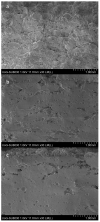3D Printing of Personalised Carvedilol Tablets Using Selective Laser Sintering
- PMID: 37765199
- PMCID: PMC10537056
- DOI: 10.3390/pharmaceutics15092230
3D Printing of Personalised Carvedilol Tablets Using Selective Laser Sintering
Abstract
Selective laser sintering (SLS) has drawn attention for the fabrication of three-dimensional oral dosage forms due to the plurality of drug formulations that can be processed. The aim of this work was to employ SLS with a CO2 laser for the manufacturing of carvedilol personalised dosage forms of various strengths. Carvedilol (CVD) and vinylpyrrolidone-vinyl acetate copolymer (Kollidon VA64) blends of various ratios were sintered to produce CVD tablets of 3.125, 6.25, and 12.5 mg. The tuning of the SLS processing laser intensity parameter improved printability and impacted the tablet hardness, friability, CVD dissolution rate, and the total amount of drug released. Physicochemical characterization showed the presence of CVD in the amorphous state. X-ray micro-CT analysis demonstrated that the applied CO2 intensity affected the total tablet porosity, which was reduced with increased laser intensity. The study demonstrated that SLS is a suitable technology for the development of personalised medicines that meet the required specifications and patient needs.
Keywords: 3D printing; carvedilol; oral; personalised medicines; selective laser sintering.
Conflict of interest statement
The authors declare no conflict of interest. The company had no role in the design of the study; in the collection, analyses, or interpretation of data; in the writing of the manuscript, and in the decision to publish the results.
Figures









Similar articles
-
Selective Laser Sintering 3D Printing of Carvedilol Tablets: Enhancing Dissolution Through Amorphization.Pharmaceutics. 2024 Dec 24;17(1):6. doi: 10.3390/pharmaceutics17010006. Pharmaceutics. 2024. PMID: 39861659 Free PMC article.
-
Fabricating 3D printed orally disintegrating printlets using selective laser sintering.Int J Pharm. 2018 Apr 25;541(1-2):101-107. doi: 10.1016/j.ijpharm.2018.02.015. Epub 2018 Feb 14. Int J Pharm. 2018. PMID: 29454028
-
Synergistic application of twin-screw granulation and selective laser sintering 3D printing for the development of pharmaceutical dosage forms with enhanced dissolution rates and physical properties.Eur J Pharm Biopharm. 2021 Jun;163:141-156. doi: 10.1016/j.ejpb.2021.03.016. Epub 2021 Apr 8. Eur J Pharm Biopharm. 2021. PMID: 33838262
-
Recent Advances in the Production of Pharmaceuticals Using Selective Laser Sintering.Biomimetics (Basel). 2023 Jul 27;8(4):330. doi: 10.3390/biomimetics8040330. Biomimetics (Basel). 2023. PMID: 37622935 Free PMC article. Review.
-
Selective Laser Sintering (SLS), a New Chapter in the Production of Solid Oral Forms (SOFs) by 3D Printing.Pharmaceutics. 2021 Aug 6;13(8):1212. doi: 10.3390/pharmaceutics13081212. Pharmaceutics. 2021. PMID: 34452173 Free PMC article. Review.
Cited by
-
Selective Laser Sintering 3D Printing of Carvedilol Tablets: Enhancing Dissolution Through Amorphization.Pharmaceutics. 2024 Dec 24;17(1):6. doi: 10.3390/pharmaceutics17010006. Pharmaceutics. 2024. PMID: 39861659 Free PMC article.
-
Selective laser sintering of distinct drug and polymer layers as a novel manufacturing strategy for individually dosed tablets.Int J Pharm X. 2025 May 21;9:100338. doi: 10.1016/j.ijpx.2025.100338. eCollection 2025 Jun. Int J Pharm X. 2025. PMID: 40502540 Free PMC article.
-
Beyond Color Boundaries: Pioneering Developments in Cholesteric Liquid Crystal Photonic Actuators.Micromachines (Basel). 2024 Jun 20;15(6):808. doi: 10.3390/mi15060808. Micromachines (Basel). 2024. PMID: 38930778 Free PMC article. Review.
-
The Future of Medicine: How 3D Printing Is Transforming Pharmaceuticals.Pharmaceutics. 2025 Mar 19;17(3):390. doi: 10.3390/pharmaceutics17030390. Pharmaceutics. 2025. PMID: 40143052 Free PMC article. Review.
-
Printabily of Pharmaceutical-Grade Polymers using Selective Laser Sintering with a CO2 Laser.AAPS PharmSciTech. 2025 May 22;26(5):144. doi: 10.1208/s12249-025-03141-4. AAPS PharmSciTech. 2025. PMID: 40404930
References
-
- Barbosa W.S., Wanderley R.F.F., Gioia M.M., Gouvea F.C., Gonçalves F.M. Additive or subtractive manufacturing: Analysis and comparison of automotive spare-parts. J. Remanuf. 2021;12:153–166. doi: 10.1007/s13243-021-00106-1. - DOI
-
- Madhavadas V., Srivastava D., Chadha U., Aravind Raj S., Sultan M.T.H., Shahar F.S., Shah A.U.M. A review on metal additive manufacturing for intricately shaped aerospace components. CIRP J. Manuf. Sci. Technol. 2022;39:18–36. doi: 10.1016/j.cirpj.2022.07.005. - DOI
-
- Menano L., Fidalgo P., Santos I.M., Thormann J. Integration of 3D Printing in Art Education: A Multidisciplinary Approach. Comput. Sch. 2019;36:222–236. doi: 10.1080/07380569.2019.1643442. - DOI
Grants and funding
LinkOut - more resources
Full Text Sources

